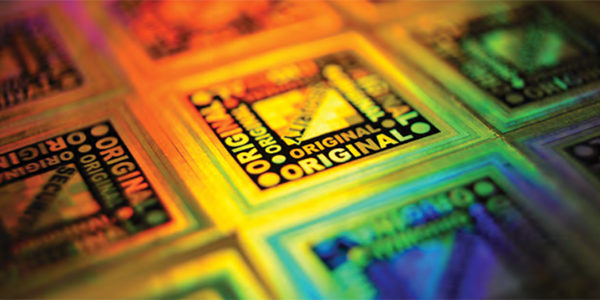The secret weapon in the fight against fakes

Whether companies want to admit it or not, product counterfeiting is a huge and growing problem. The global value of counterfeit goods runs to $1.5 trillion per year and is increasing at a rate of 3 percent annually, according to estimates from PMMI, the association for packaging and processing technologies.
Counterfeiters are creative folks and have come up with a number of different ways to make a buck off your brand. Here are just a few examples:
Label swapping: A common type of counterfeiting, this method involves removing the price tag from an article and replacing it with a tag for a lower-priced item.
Product divergence: This type of fraud occurs when products meant for one geographic market or channel (and priced accordingly) are sold in another market at a price lower than you'd typically find there. For example, a high-end piece of furniture intended for sale in Mexico ends up at a warehouse club store in Texas at the price meant for the Mexican market.
Authentic packaging, fake product: Someone at your packaging provider does an overrun of your packages (such as shoe boxes or cartons) and sells them to a counterfeiter, who then places fake goods in them.
Fake packaging, fake product: Fraudsters create a replica of your packaging, for example using Photoshop, and fill it with fake product.
And it's not just luxury goods or pharmaceuticals that are at risk. Robert Ryckman, vice president of market development for the labeling company CCL Industries and who has been working on product security for 20 years, has seen cases of counterfeiting that involved products worth only a dollar. As for why fraudsters would bother with low-value items, it's a matter of expedience. It's easier to produce a tube of fake toothpaste or shampoo than a fake luxury item. Plus, consumers are less likely to be suspicious of cut-rate toiletries than of severely discounted Rolex watches or Coach bags.
So how can you better protect your goods from counterfeiting? Part of the solution might be right under your nose: the packaging and labeling you already use for your products.
"Packaging is one possible countermeasure or control system [in the fight against counterfeiting]," says John Spink of the Food Fraud Initiative at Michigan State University. It's typically used in one of two ways, he says. "Sometimes, it helps authenticate the product or protects it from being tampered with. Other times, it provides monitoring of the movements."
Because almost every product has some sort of package or label, packaging provides a great vehicle for carrying anti-counterfeiting technology, Ryckman adds. It also ensures that the "authentication" for the product—typically, a difficult-to-copy identifying mark—is always traveling with it.
OVERT AND COVERT OPSWhen it comes to authentication technologies for packaging, companies have no shortage of options. They can choose from holograms, special seals, and color-shifting inks, to name just a few. As sophisticated as they may sound, Ryckman of CCL warns that none of these solutions can do the job alone. Instead, he recommends a multilayered approach that uses more than one technology to verify that the product is not a fake.
That might sound like overkill, but it can help you stay one step ahead of the bad guys. Fraudsters are becoming increasingly creative in finding ways to breach their targets' supply chains (see sidebar). And these days, they have ready access to tools that allow them to replicate common anti-counterfeiting technologies. For example, it's now possible to buy many different types of holograms on Alibaba or to reproduce bar codes or serial numbers using Photoshop. Deploying more than one anti-counterfeiting technology on your packaging or labels makes it harder for fraudsters to reproduce your markings.
For best results, a multilayered approach should include at least one "overt technology" and one "covert technology," Ryckman says. "Overt" technologies are those that are discernable to the average person with no tools or training, but are difficult to reproduce or replicate. Some examples include special hologram labels, watermarks on the packaging, tamperproof labels that disintegrate when they're peeled off, and specialty inks that change color depending on the viewer's angle.
"Covert" technologies, on the other hand, are those that are not immediately discernible to the average person and are visible only with additional tools (or that require training on where or how to look for the authentication). Examples include bar codes, radio-frequency identification (RFID) tags, microtext that requires magnification to be read, and special types of "invisible" ink that can only be seen under infrared or ultraviolet light.
THE BACKBONE: SERIALIZATIONWhether they incorporate overt or covert technologies (or some combination of the two), most good authentication programs make use of serialization, Ryckman says. Serialization, or the practice of assigning a unique identification number to every item, might sound complicated, but it's not. It can be as simple as printing a serial number on the product or packaging, or using a bar code.
Historically, serial numbers were only used for high-value goods, but the advent of digital printing has made serialization a cost-effective solution for a broader range of items. "It's possible now to have individual labels printed at high speeds with high resolutions, and those can be printed directly on a case," says independent packaging consultant Tom Blanck. "That gives you the opportunity for serialization where every single case has a different unique number, date, and location, and allows for that information to be fed back into the warehouse management system."
Two-dimensional (2-D) bar codes, which use squares, rectangles, and dots to encode product information, are an especially effective tool for serialization, according to Dave Reba, director of consumable sales for data-capture solutions specialist Barcoding Inc. Compared with one-dimensional (1-D) bar codes, the 2-D versions are harder to replicate and can include more information. However, they're not "bulletproof." The codes can be compromised or counterfeited, which can create serious headaches for suppliers, Ryckman warns. "Once a serialization number has been duplicated, it's difficult to tell which product is authentic and which one is fake," he says.
In addition to 1-D and 2-D bar codes, there are some emerging technologies that have the potential to take serialization to the next level where security is concerned. Here are just a few examples:
- Invisible bar codes. "Invisible" bar codes are imperceptible or barely perceptible to the human eye and are typically printed all over the package or label. Among other advantages, they can be scanned with a regular bar-code or QR scanner (like the ones found in most smartphones). Plus, they can encode the same amount of information that a 2-D code can but in a much smaller space.
Because the bar codes are embedded into an image on the package, they're also difficult to reproduce, according to Tony Rodriguez, chief technology officer of the invisible bar-code provider Digimarc. "You can't go into any image in Photoshop and insert [an invisible bar code] into it," he says. "You need the key [for deciphering the bar code], the software, and the tools [for creating it]." Invisible bar codes "are essentially in the DNA of the imagery," he adds. - Microtaggants. Microtaggants are microscopic particles that serve as a virtual fingerprint for each individual product or item. They can consist of an inert material, an alphanumeric code, or even a molecular or DNA tag that's embedded into the ink or top coat of the label or packaging.
Unlike 2-D bar codes or RFID tags, these taggants cannot be copied, says Janice Meraglia, vice president of military and government programs for DNA taggant producer Applied DNA Sciences. However, they do require a special reader. Applied DNA's taggants, for example, require a reader that's about the size of a coffee can and is capable of reading 16 different DNA taggants simultaneously in 30 minutes, Meraglia says. - RFID. Although we've been hearing about radio-frequency identification for decades, RFID is only now emerging as tool for fighting counterfeiting, Reba says.
"We're finding that RFID is changing rapidly in terms of the designs of labels, nanochips that go into those labels, antennas, and the technology that reads, receives, and transmits [the information]," he explains. "So that whole technology piece of the puzzle, I still consider to be on the emerging side."
The advantage of RFID labels is that they're difficult to counterfeit and hard to detect, according to Reba. The downside is that the tags are still costly, making them suitable mainly for high-value goods, he says.
As cool as these new technologies might sound, not everyone's ready to endorse them. Some packaging and labeling experts believe they have yet to prove their worth and remain cautious about recommending them to clients.
"Emerging technologies are still being tested and are sometimes really expensive," warns Reba, who typically recommends that his customers use more mature technology. "One-D and 2-D bar codes can be used without a lot of cost," he adds.
Eric Carlson, senior manager for Chainalytics' packaging optimization consulting service, agrees, saying that newer technologies still have to prove that they can be read quickly and easily for authentication purposes. "[In comparison,] bar coding and the infrastructure behind it is well established and well integrated into many enterprise resource planning systems, warehouse management systems, and other business software," he says.
BEYOND THE TECHNOLOGYIt's important to keep in mind that, for all they can do to protect product integrity, packaging and labeling are only one front in the fight against fake goods. Spink of Michigan State says packaging controls should be part of a larger holistic program that starts with an assessment of what type of counterfeiting is happening and how fraudsters are getting their product into the marketplace.
Rodriguez of Digimarc agrees. "The partners that we've seen be successful are the ones that have really thought this problem through; they understand the origin of the threat and how it's being done," he says. "They know where in the supply chain it's happening. And then they really get down to what their economic objectives are in trying to clamp down on the problem."
Related Articles

Copyright ©2024. All Rights ReservedDesign, CMS, Hosting & Web Development :: ePublishing